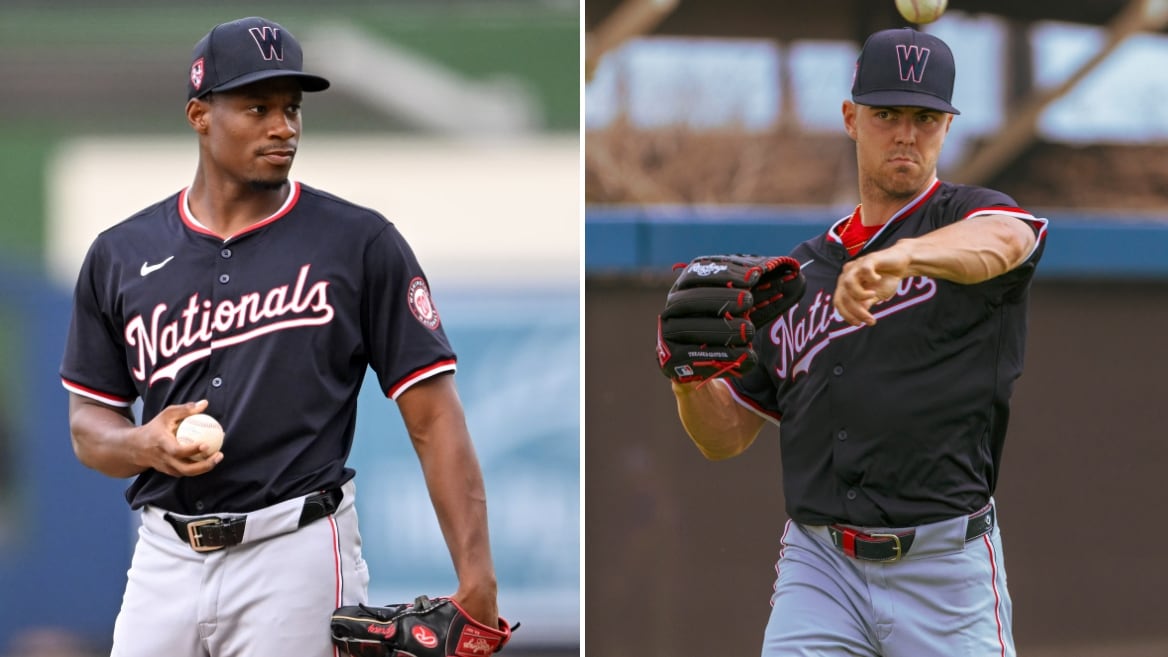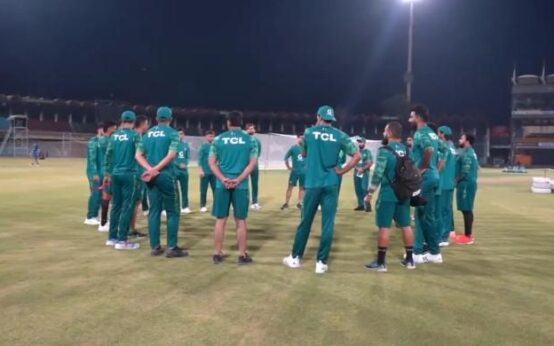Not bad for a Tuesday in Rancho Cucamonga.
As they tended to do back then, right-hander Josiah Gray (Dodgers affiliate) and left-hander MacKenzie Gore (Padres affiliate) were dealing. Two aces-in-the-making, pitching 6⅔ (Gray) and seven (Gore) scoreless innings, perhaps wondering if their hitters could offer any run support against that dude in the other dugout.
“He was the top pitching prospect in baseball, so it was like, ‘Holy crap,’ ” Gray said. “Being able to match zeros with him was really, really surreal.”
What they didn’t imagine at the time: that they would play for the same organization, the Washington Nationals, in just over three years’ time. Or that the same Nationals front office that built a World Series champion on the back of a strong pitching staff would ask them to shepherd the next one in. Or that the pair would serve as could-be-tragic-but-hey-this-may-actually-work-out figures, acquired in trades for the core of that championship team (Max Scherzer et al. for Gray et al.; Juan Soto et al. for Gore et al.).
Gray, a curious mind who loves to tinker, and Gore, a meticulous and driven student of pitching, have different backgrounds and relationships with the spotlight, but now they’re in this together. Together, Gray, who will start on Opening Day, and Gore, who will be on the mound for the home opener, hope to be part of a Washington team that could turn a corner in 2024, as a new stage of its rebuild takes shape and the second wave of prospects knocks at the door they only recently entered. And, really, they said ahead of the start of the season, they’re comfortable.
“They both came over in extremely high-profile trades for arguably Hall of Fame caliber-players,” pitching coach Jim Hickey said. “So there’s probably a little more commonality there between the two of those guys and what they’ve gone through than [you’d think].”
Gray was the type of 13-year-old who got invited to every bar and bat mitzvah in New Rochelle, N.Y.; who would get up and speak effortlessly at Sunday school; who, 13 years later as a National, is arguably the team’s most front-facing figure, both with the media and in the local community. But he always kept his own circle tight.
When his mom, Monica, visited him at spring training, she saw the same low-key kid in his grown-up, postgame routine: He cooked dinner with his girlfriend, watched TV and called it a night.
“He’s not going to change,” she said. “He really isn’t.”
Gray’s affable, understated nature does not mean he lacks an edge to his game or can’t find a different gear on the mound. There is something inside Gray that clicks under pressure, which makes sense. He had one college scholarship offer. He was drafted by Cincinnati in the second round in 2018, was traded away after a year in the Reds’ system and began 2019 as the 19th-ranked prospect in the Dodgers’ system. Then he was traded again. Even if it’s not his natural MO, Gray has always been comfortable on bigger stages. It just took a while for the world to grant him the chance to play on one.
“I never really grasped that concept of, like, ‘Hey, you’re the guy we want to build around,’ ” said Gray, who didn’t feel overlooked exactly, more lost in a crowd. “So being with the Nationals over the last few years, seeing the way the roster has turned and I’m going to be one of the pitchers that they rely on to make big starts, it means a lot.”
Perhaps that’s why Gray feels his best when the pressure is on and the tension is thickest. Why, at least in part, he pitched a perfect inning in last year’s All-Star Game. Why he was 39 percent better than the MLB-average pitcher in high-leverage situations and 18 percent worse in low-leverage ones. Why he was one of the rare pitchers who were more effective the third time against the order than the first.
“For me, it’s just knowing I’m one pitch away,” Gray said.
The next step in his development, Gray and the coaching staff said, is not getting himself in those high-leverage situations in the first place. For that, he can look to his steady teammate.
If you ask around for the MacKenzie Gore story, you’ll usually be met with a few seconds of introspection.
“The demeanor doesn’t really change,” right-hander Jake Irvin said. “He has a little bit of swagger. … He might give a little yell.”
“MacKenzie’s got an even keel,” Manager Dave Martinez said. “Until he goes on the mound. Then it’s ‘bloop.’ ” Martinez pretends to flip a switch, then laughs.
Hickey’s response is simple: One time this winter, Gore called him from a beach in North Carolina.
“That’s a good caricature of him,” Hickey said. “I could just picture him just kind of sitting on the beach, looking at the water in the sun and just kind of chilling out and not having a care in the world.”
This, of course, helps when you’re accustomed to the weight of expectations. Gore has been in the limelight since he was 15; he was the third pick in the 2017 draft and was once the top pitching prospect in all of baseball. Now he has been tasked with helping lead a team that won 71 games last year to even bigger things down the road. For some, that would be enough to shudder.
But, Gore said, that’s the thing about pitchers.
“Pitchers have some loose screws,” he said.
“It’s probably not a question I can answer,” Gore said. “You’ll have to ask someone else about it.”
The consensus: It’s being steady when everything suggests he shouldn’t be, such as when he struck out the first six Padres batters in his return to San Diego. It’s that unshakable demeanor, finding that extra bit of juice when he needs it, now the grown-up version of an adolescent Gore who would go mute after losses. It’s that dominance; that his peak stuff, particularly his fastball, is up there with any starter’s in baseball, per FanGraphs’s Stuff+ metric. Still, he finished last season with a 4.42 ERA.
It’s not the great outings that need to get all that greater. It’s the bad outings that need to become not as bad.
And that’s what makes him so close to becoming a potential ace.
“Taking it day by day is a real thing,” Gore said.
“I thought he could be a really, really good starter, maybe a top-10 kind of a guy,” Hickey said. “Anytime you’re left-handed and you throw that hard and you have the stuff that he has, that’s something that you would consider. But after watching him now pitch and at times just dominate, there’s no question in my mind now that he could be top 10 for sure, if not the top gun [in MLB].”
‘The beauty of baseball’
Catch a bullpen session, and you’ll see what Washington hopes for. Every few pitches during their mound sessions, Gray and Gore will stop and look at the iPad for tweaks. They’ll ask questions, to the staff and to each other. Oftentimes, when one is throwing, the other pops over from another part of the field, leans against the fence and starts watching from behind.
As Gore and Gray go, so goes the Nationals’ future. They know that. Gore helped Gray gain confidence in his fastball. Gray helped show Gore what a detailed routine entails.
The in-game adjustments, members of the staff said, are the next steps. Gore’s best stuff is nasty, but he must be able to slow his mind down enough to throw it consistently. Gray’s best pitches are so good — not to mention he has seven of them — if only he didn’t save the best until he needed one final pitch to get out of an inning.
At the end of a bullpen session in mid-March, Gore walks over for one more of Gray’s bullpen sessions. He chats under his breath with a staffer, seeming to pay little attention to the conversations around him. Every time Gray begins his windup, however, his eyes dart over to the mound.
“That’s also the beauty of baseball,” Gore said. “There’s a lot of different personalities. I learn a lot from people who think differently. I think that’s really cool.”


 Best Underground Water Leak Detection Equipment 2024
Best Underground Water Leak Detection Equipment 2024  Best Backyard Ideas: Turn Your Outdoor Area Into a Creative and Calm Haven
Best Backyard Ideas: Turn Your Outdoor Area Into a Creative and Calm Haven  Babar, Rizwan are good players but not whole team, says Mohammad Hafeez
Babar, Rizwan are good players but not whole team, says Mohammad Hafeez  Pak vs NZ: Green Shirts aim to bounce back against Kiwis today
Pak vs NZ: Green Shirts aim to bounce back against Kiwis today